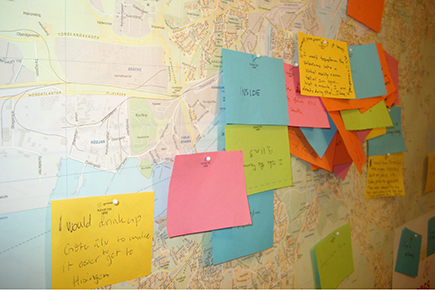Public Play Spaces
Images
1
2
3
Public Play Spaces was a platform for exploring the playful, emotive, and critical incorporation of technology in everyday public life. Drawing on art, architecture and activism, focus was on catalyzing new forms of engagement. As public space seems to be increasingly privatized and policed, we argued that interaction design is too focused on putting technology everywhere, ubiquitously and indiscriminately, in our personal lives and public spaces. To ask such questions and speculate on alternatives, we threaded such concerns through a series of project collaborations, courses, and events. For us personally, and in collaboration with others, these were means of experiencing and expressing the diverse social dimensions of everyday public spaces. Public Play Spaces emphasized personal and public engagement, in which we explored participatory modes of prototyping, experimental actions ‘in the field’, and subcultural practices. By emphasizing and expanding the social interaction aspects of interaction design, we also developed approaches that queried where, when, how, for and by whom technology was present.
As a platform, Public Play Spaces was built up from our work in other, funded projects as well as activities commissioned from cultural funds or from teaching. Underdogs & Superheroes, conducted partly in conjunction with our course Epic Everyday at the IT University Göteborg, developed game- and narrative-based methods for involving wider participation in urban and technology development. Reach, conducted through the IT+Textiles project, developed a line of interactive wearable pieces that changed patterns to reflect the local environment and the emotional content in relationships. Sonic City was a wearable music experience, conducted in conjunction with the Smart-Its project and the IT+Textiles project. Tejp was a do-it-yourself, decentralized system for leaving audio graffiti, commissioned by the Living Art Museum in Reykjavik, Iceland, and by the RX Gallery, San Francisco, US. Kinetic Shadows, a system of interactive street furniture, won an international competition commissioned by the Athens 2004 Organizing Committee for the Olympic Games.
Public Play Spaces also initiated and hosted a series of events, including the [fringe] monthly series of art and media gatherings, seven public seminars entitled DESIGNINART, and the OUTSIDE IN international symposium on the design and use of public space.
Image (above)
(1) Underdogs & Superheores game 3, (2) Tejp installation for the Living Art Museum, and (3) simulation of Kinetic Shadows for Athens 2004. Photo credits by project teams as listed on the Public Play Spaces website (link below).
My role
Together with Margot Jacobs, I jointly initiated and managed Public Play Spaces between 2002 and 2005. This included defining the research approach, scope, collaboration and funding, as well as conducting research within Sonic City, Underdogs & Superheroes and Kinetic Shadows. Several of the projects within the platform are collaborations between the Interactive Institute and the Viktoria Institute. Funding for projects come from VINNOVA (through the IT+Textiles project), European Union's FP5 program (through the Smart-Its project), the Nordic Institute for Contemporary Art (NIFCA), and the Nordic Culture Fund.
More about the project
www.tii.se/projects/public-play-spaces
[fringe] art and media events website
See also
/ Projects / Sonic City
/ Projects / IT+Textiles
/ Projects / Smart-Its
/ Teaching / Ljud, MA/MFA course, Göteborg University.
/ Teaching / Epic Everyday, MSc course, IT University Göteborg.
/ Teaching / Thesis projects / Dahlberg, A., and Götesson, A., 'Bridging the Gap', MSc in Interaction Design, 2004.
/ Events / Outside In
/ Publications / Mazé, R. (2007) Occupying Time.
/ Publications / Mazé, R., and Redström, J. (2005) ‘Form and the Computational Object’.
/ Publications / Jacobs, M., and Mazé, R. (2004) ‘Design-by-Doing’.
/ Publications / Mazé, R. (2004) 'Design and Use of Public Space' and 'Beyond Utility'.
/ Publications / Mazé, R., and Redström, J. (2004) ‘Form and the Computational Object’.
/ Publications / Mazé, R., and Jacobs, M. (2003) ‘Underdogs and Superheroes’.

